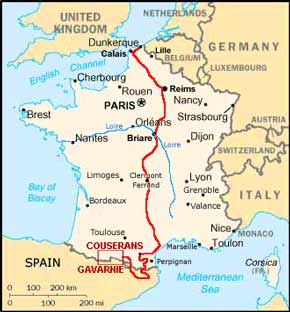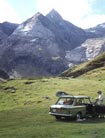|
|
PYRENEES REVISITED Week 7~8 News |
||
|
'Le Grand
Chaud' declared the headline in le Dépêche
the Ariège local newspaper. And so it was, the Great Heat, with
temperatures in the mid 30ºs, 10º above the seasonal average.
Across eastern France, départemental bureaucrats were declaring red
alerts against an anticipated 2005 canicule (heat-wave), not wanting to be
caught napping as in 2003 when several 1000s of elderly died from heat
stroke. The French Minister of Health responded to accusations of scare
mongering by pontificating that something had to be done; for a little
light relief, follow the comedy on the official heat-wave web site www.sante.gouv.fr/canicule We camped first just outside St Girons, the main town of the area, near to the ancient ecclesiastical centre of St Lizier. The small village owns 2 cathedrals, dating from pre-12th century, and a turreted Bishop's Palace which graces the hilltop. It is also on the St Jacques de Santiago Compostela pilgrimage route - did you pass this way, Liz? Our visit coincided with the feast day of St Jean-Baptiste, when many Catalan and Pyrenean villages celebrate what is almost a pre-Christian Midsummer festival with bonfires, dancing and feasting. On Midsummer's Eve, we attended the Feu de St Jean at St Lizier, with an enormous bonfire in the square by the cathedral, cacophonous ringing of the bells, children's torchlight procession and general revelries (Photo 1). It was a wonderfully straightforward local celebration, and the following morning the remains of the bonfire were still glowing hot as we drove past, up into the Salat and Ustou valleys of the Haut Couserans. Of all the superb campsites we have found this trip (and recommended to others via this web site), we had so far singled out l'Agly at St Paul de Fenouillet and Vall de Ribes, both for their magnificent setting and the hospitality we received. Well here at Trein d'Ustou was another contender for 'Campsite of the Trip' accolade - the wonderfully sited Camping le Montagnou where we received a delightful welcome from M et Mme Seysell. They had every right to be proud of the campsite, which they had literally carved out of the valley floor, clearing the ground and levelling the site. It was now described as 'Camping calme pas d'animations' - peaceful with no entertainments. What more did you need, but to look out on the steep-sided afforested valley walls, directly up to the jagged snow-covered peaks which formed the southern wall of the Cirque de Cagateille. From our camp at Trein d'Ustou, we climbed up to this spectacular mountainous amphitheatre, sculpted out of the towering peaks by glacial action. The approach path through beech woods gave welcome shade from the intense mountain sun, and as we emerged from the trees into the high flat valley, there ahead sweeping around through more than 180º was the monumental natural Coliseum of the Cirque de Cagateille. The cwm walls rose up more than 1000 feet, streaked with water courses falling sheer from the surrounding hanging valleys above (Photo 2). Not only was the Cirque spectacular on a geological macro-scale, it was equally attractive on a botanical micro-scale: the valley floor was a glowing carpet of wild orchids - we counted 5 different varieties. And amongst the bracken, we at last found the elusive and iconic Pyrenean Lily, an elegant wild flower looking for all the world as if straight from a florist's window - Click here for alpine flora photos For sheer classic Pyrenean mountain beauty, the unfrequented Cirque de Cagateille more than rivals the more famous Cirque de Gavarnie. Our next stop in the Couserans was over the Col de la Trappe at Aulus-les-Bains, a former spa village now more geared to the lucrative winter ski trade. You would, if feeling generous, describe the municipal campsite as mediocre, though mountain surroundings more than compensated, as did Sunday supper of BBQ-ed succulent gigots of lamb with local fageolet beans. The reason for our visit was the Cascade d'Ars at 1500m in a side valley above Aulus, where the Ars river drops some 360 feet in 1 major fall then a magnificent series of fantailed cascades. The path zig-zagged up through beech woods, thankfully giving shade on a sultry, humid day. As the trees thinned, there ahead was the full drop of the Cascade, leaping in clouds of spray over the rim of the higher hanging valley and spreading its fantails over the lower rocks before disappearing into the ravine below (Photo 3). But the sky was now becoming heavily overcast, and the sultry heat and first spots of rain indicated a storm. Electrical storms in mountain terrain are an unnerving experience, and the return to the valley in lashing rain brought us another soaking. The storm signalled a respite from the canicule as the newspaper announced 'Coup de chaud avant les orages'. The storms followed us over to the western valleys of Couserans; the roads were littered with tree debris brought down by the violent gusty winds. At Sentein, high up in the curiously named Valley of Biros, the municipal campsite was delightful. With the storms worsening, we pitched in open space well clear of trees. Even so, the gusting wind hurled branches across the site and buffeted the camper. Two mature trees on the river bank were simply snapped off before our eyes to fall across the river, and it continued raining all night and into the following day for a wet walk to the Lac du Bethmale. Trying to outrun the storms, we moved further westwards to the Comminges in the Pyrenean foothills of the upper Garonne valley to camp just outside St Bertrand de Comminges. The medieval fortified hilltop village had its origins during the unsettled times following the Roman Empire's collapse and incursions of barbarian tribes into southern Gaul. The Roman colony of Lugdunum had prospered during the first 3 centuries AD, and the extensive excavated remains of the Roman town spread out across the valley below the later medieval village. But what distinguishes St Bertrand is the magnificent Romanesque and Gothic cathedral perched on the hilltop, looking sturdily monolithic with its prominent and ponderous buttresses. Again this was a stopping point on the Compostela pilgrimage route, lucrative business for the canons of the day. Here on this site you could witness 2000 years of urban development from the archaeological remains of Roman Lugdunum's baths, temples and markets, to St Bertrand's medieval cathedral and half-timbered 16/17th century houses crowning the hilltop. And in the nearby village of Valcabrère, the 11th century Basilica of St Just was built using recycled stonework from the ruins of Roman Lugdunum: columns, capitals, blocks and fragments of sarcophagi. It was a superb day of historical explorations. Time was moving on: Saturday 2 July saw the start of the French holiday period with newspapers predicting the usual traffic chaos; it was also the start of the Tour de France. We headed westwards to the central Pyrenees for the climax of our trip - 4 days camp at Gavarnie. Our base was the Pain de Sucre campsite, set in the gorge just before Gavarnie village. This camp had the most outstanding view of the trip, looking straight up to the mountainous head of the valley, and a glimpse of the Brèche de Roland on the skyline which still glowed pink from the setting sun at 9-30 at night. The
English language contains insufficient superlatives to do full justice to
the Cirque de Gavarnie. Beyond the village,
We
shall publish 1 further web to conclude the trip - and with luck, we hope
to include another photo of the
Brèche
de Roland to complement that of 1973 shown in our Pyrenean Prologue web
site. Keep watching
|


 you
quickly leave behind the trippers who swarm here in their millions. There
in front of you for the hour's walk towards the Cirque is the most
awe-inspiring mountain wall in Europe. As you crest the curving narrow
entrance to the rim of the Cirque's upper cwm, the utterly breath-taking
spectacle of this almost perfect semi-circular natural amphitheatre greets
you. The Cirque was scoured out by glacial action, 1400m from top to
bottom, and 890m in sweeping diameter. The formidable enclosing walls rise
vertically in 3 stages with layers of granite sandwiched between limestone
beds, separated by steep terraces banked with snow and ice (Photo 4).
The Cirque's summit rim is formed by nine 3000m peaks, curving round 5 kms
along the Franco-Spanish border. All around, cataracts streak down the
Cirque walls, and on the left, the enormous 423m drop of the Grande
Cascade, the longest waterfall in Europe (see photo left). At the foot of
the falls on the
you
quickly leave behind the trippers who swarm here in their millions. There
in front of you for the hour's walk towards the Cirque is the most
awe-inspiring mountain wall in Europe. As you crest the curving narrow
entrance to the rim of the Cirque's upper cwm, the utterly breath-taking
spectacle of this almost perfect semi-circular natural amphitheatre greets
you. The Cirque was scoured out by glacial action, 1400m from top to
bottom, and 890m in sweeping diameter. The formidable enclosing walls rise
vertically in 3 stages with layers of granite sandwiched between limestone
beds, separated by steep terraces banked with snow and ice (Photo 4).
The Cirque's summit rim is formed by nine 3000m peaks, curving round 5 kms
along the Franco-Spanish border. All around, cataracts streak down the
Cirque walls, and on the left, the enormous 423m drop of the Grande
Cascade, the longest waterfall in Europe (see photo left). At the foot of
the falls on the 
